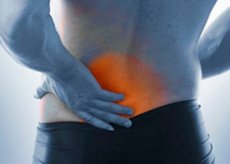Medical expert of the article
New publications
Pseudospinal pain
Last reviewed: 08.07.2025

All iLive content is medically reviewed or fact checked to ensure as much factual accuracy as possible.
We have strict sourcing guidelines and only link to reputable media sites, academic research institutions and, whenever possible, medically peer reviewed studies. Note that the numbers in parentheses ([1], [2], etc.) are clickable links to these studies.
If you feel that any of our content is inaccurate, out-of-date, or otherwise questionable, please select it and press Ctrl + Enter.

Back and/or leg pain can be a symptom of diseases:
- Systemic
- Visceral
- Vascular
- Neurological disorders
- Pseudospinal pain is not uncommon
Abdominal aortic aneurysm
- 1-4% in the population over 50 years of age
- 1-2% of all men who die around age 65
- Abdominal pain radiating to the thighs
- 12% have back pain
- Diagnostics: ultrasound or CT
Endometriosis
- Reproductive age
- Pelvic pain
- Abdominal pain
- Back pain 25-31%
- Diagnostics: laparoscopy
- treatment: oral contraceptives, danazol (testosterone analogue)
Other disorders
- Fibromyalgia - 2%
- Trochanteric bursitis - 25%
- Inflammatory diseases of the pelvic organs
- Prostatitis
- Lifetime frequency 50%
- Nephrolithiasis 3%
- Pancreatitis and pancreatic cancer
- Pain in the epigastrium radiating to the back
Infectious diseases of the spine
Osteomyelitis
- A Rare Cause of Back Pain
- 1:20,000 according to hospital statistics
- Most commonly caused by gram-positive cocci
- Urological infections are the most common cause
- Hematogenous spread (excluding vertebral injections)
- There is almost always back pain.
Discitis
- Osteomyelitis and/or hematogenous spread
- Surgical or diagnostic procedures
Infectious lesions of the spine
- Cervical - 8%
- Cervicothoracic <1%
- Chest - 35%
- Thoracolumbar - 8%
- Lumbar - 42%
- Lumbo-sacral - 7%
- Sacral <1%
Sources of spinal infections (in half of all cases cannot be determined)
- Genito-urinary tract - 46%
- Leather - 19%
- Respiratory tract - 14%
- Spine surgery - 9%
- Blood - 4%
- Intravenous infusions - 3%
- Teeth - 2%
- Bacterial endocarditis - 1%


 [
[